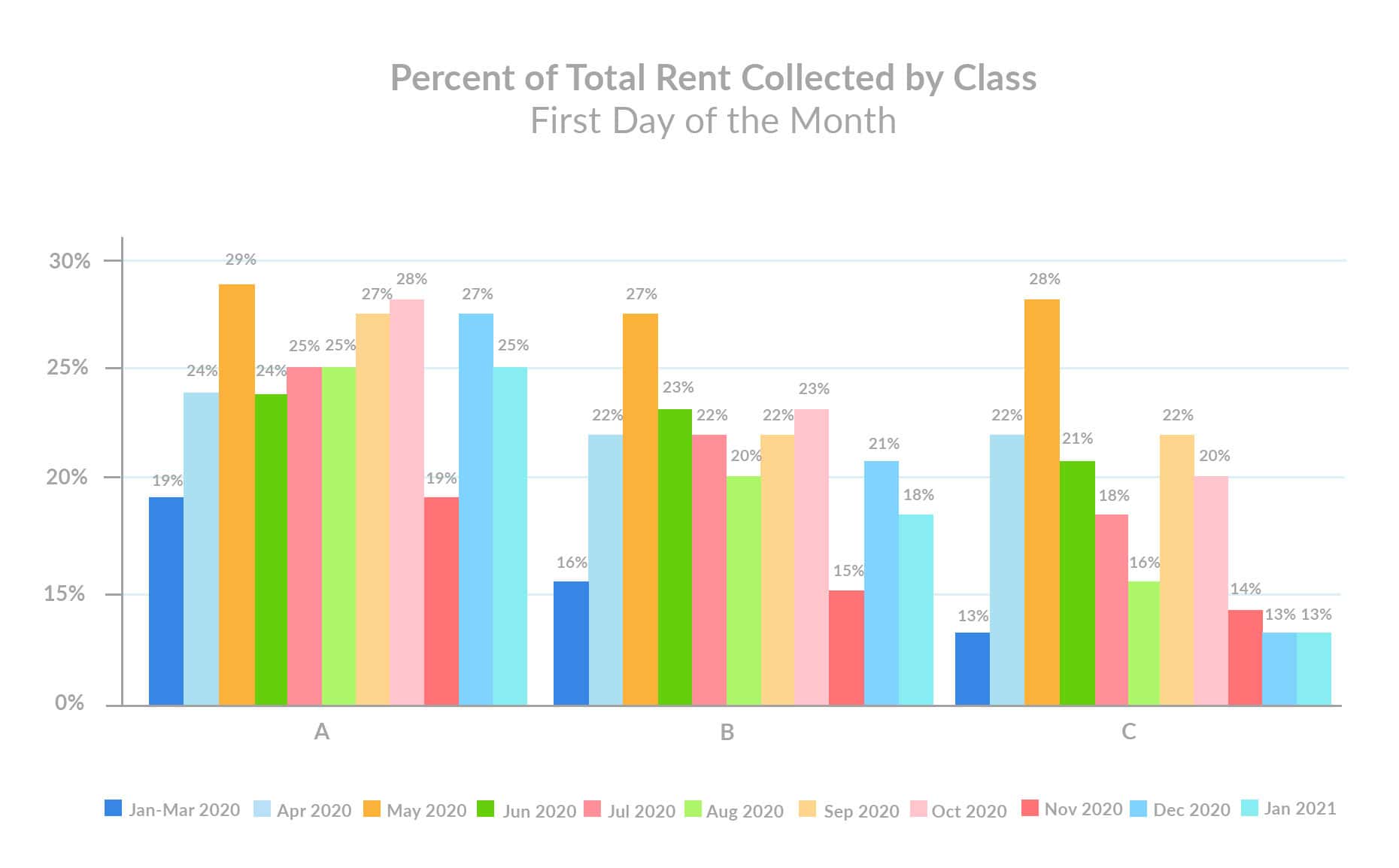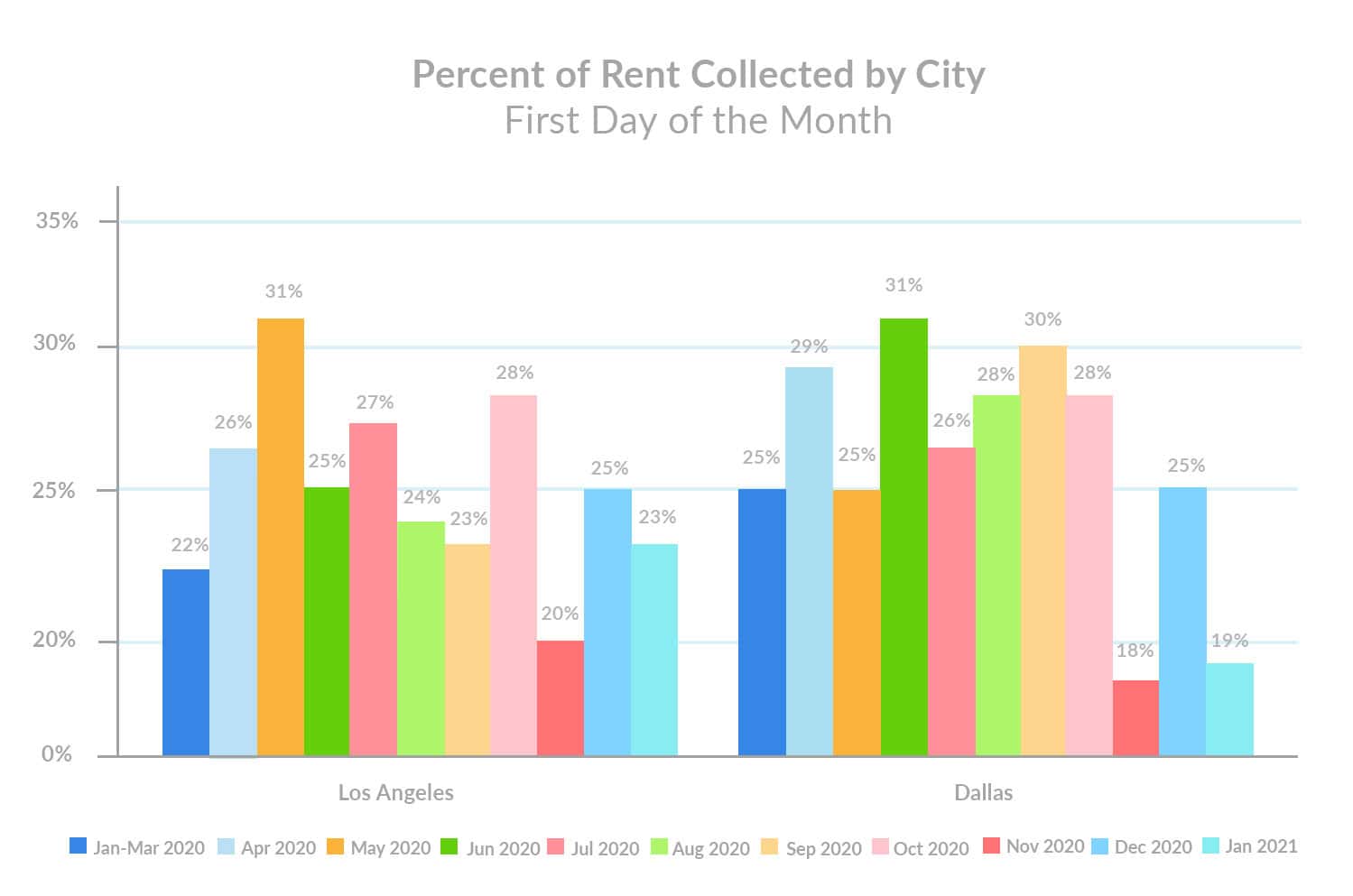January 1st Rent Payments: $900 Billion COVID Relief Package Passes
- Percent of rent collected on January 1st slipped 2 points MoM.
- First-day rent payments steady across Class C properties.
- Stimulus package includes $25 billion in rental assistance.
At the turn of a new year, the multifamily industry continues to battle economic volatility, increasing unemployment rates, and a pandemic resurgence. While President Trump signed the $900 billion relief package — including $25 billion in rent relief — and despite a rebound last month, first-day rent payments in January have slightly dipped.
In a joint statement, President of NMHC, Doug Bibby, and President and CEO of NAA, Bob Pinnegar, agree that more assistance is necessary to stabilize the apartment rental industry in 2021:
“We are heartened that the legislation includes such critical resources that will allow those impacted by COVID and resulting economic distress to meet their financial obligations, including rent. NMHC and NAA will continue to work with policymakers on future legislation to ensure that residents and housing providers have the support necessary to allow for a sustainable and equitable recovery.”
Both organizations have remained steadfast in their fight to support apartment operators and American renters since the onset of the pandemic. In support of that effort, we’ve evaluated rent payment behavior by region and asset class in the first month of 2021.
January 1st Rent Payments Slightly Dip
The percent of total rent collected on the first of January declined 2 percentage points since December. Despite optimism from the uptick in December 1st rent payments and the passage of a COVID relief package, renters are struggling after several months of financial distress. On the whole though, first-day rent payments in January have held stronger than the most significant dip in November.
Class C Rent Payments Stabilize — Class A & B Properties Slip
The percent of total rent collected on the first-of-the-month at Class A and Class B properties dipped 2 and 3 points, respectively. While Class C properties have struggled historically, first-day rent payments at Class C apartments remained steady in January following a slight drop last month — on par with the pre-COVID average.
Compared to the large drop in November, Class A and Class B properties are now in a stronger position. And while Class C first-day rent payments have not changed since December, they’re still below the previous low in November. This again underscores the dire need for rental assistance as the pandemic continues to wear on America’s most vulnerable renters.
Rent Payments Decrease in California and Texas
In California, renters still face a crippling housing crisis exacerbated by a lack of state rent relief. California Rep. Maxine Waters noted that the $25 billion in emergency rental relief is “a start” which is evidenced by the slight 1-point drop in the percent of rent collected on January 1st.
In Texas, a rent assistance program is set to roll out in the spring. As lawmakers iron out some kinks, the state experienced a 7-point drop in the percent of rent collected on the first-of-the-month.
A major metro drilldown in both states reveals a slight decrease in the percent of rent collected on the first-of-the-month. In Los Angeles, January 1st rent payments slipped 2 points, while Dallas suffered a 6-point drop from last month.
What the $900 Billion Stimulus Package & $25 Billion in Rent Relief Mean for Multifamily
Renter’s financial security appeared to be on the rebound last month. This month, even a small dip in first-day rent payments indicates the deep-rooted financial strife that renter households face, despite an eviction moratorium legislation and various emergency rent assistance funds.
The prospect of federal rent relief is now a reality, however, the apartment industry understands that short-term, fractional funding is insufficient as the pandemic persists through 2021. After months of desperate lobbying efforts by industry groups to gain more comprehensive rent relief measures, apartment housing leaders and legislators can only breathe a temporary sigh of relief.
Looking ahead, multifamily leaders will continue to support the industry. And to that end, we will track rent payment behavior over the course of the new year.
Important statistical note: Despite the measured payment fluctuations based on the sample set, the variance is within normal statistical range. In other words, the changes are not necessarily significant enough to attribute specifically to COVID-19 versus normal fluctuations expected across the data set. Please reference full Methodology below.
Methodology
Rent payment data is actual transactional data sourced from integrations with property management systems in the multifamily industry.
Analysis includes a 105,070 unit sample from 1,029,428 live units under management by LeaseLock clients. Data is nationwide, representing over half of the NMHC Top 10 property managers in the country and all asset classes (A, B and C). Asset class composition: class A (39%), class B (43%) class C (18%).
All data has been anonymized to remove personally identifiable information for renters and property managers.








